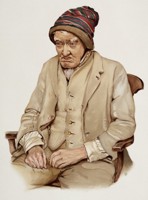Sometimes Simple Is Better - Randomized Study Finds Acupressure Improves Cognition

Chinese Medicine, which encompasses acupuncture, is a broad and complex system of medicine. At face value this is neither a good or a bad thing, but the complexity of the diagnostic systems and treatment methods can limit broad usage due to limited numbers of well trained practitioners.
Acupressure is often touted as a home remedy. Many practitioners, myself included, will recommend certain acupressure points and techniques to patients. But we are also well aware of the limitations when compared with full acupuncture treatments.
As a practitioner, I know all too well how difficult proper acupuncture can be to obtain for many people in the world. For many, some simple acupressure may be all they will ever have access to. Even if it helps a small amount, that is still a very good thing in terms of global health.
The study that I’m exploring today provides a pristine example of the effectiveness of relatively simple acupressure points on a growing, complex and global issue - cognitive disorders in the elderly. The research paper is entitled “Acupressure Improves Cognition and Quality of Life Among Older Adults with Cognitive Disorders in Long-Term Care Settings: A Clustered Randomized Controlled Trial”. The researchers were from a range of institutions in Taiwan (China Medical University) and Australia (The University of Sydney), among others, and the participants were recruited from 18 long term care facilities in Taiwan.
The study itself was somewhat small, 46 participants in the treatment group and 46 in the control group. The participants, however, were from 18 different facilities and was assessor-blinded and randomized.
The treatment involved 3 minutes of acupressure stimulation at each of the 8 treatment points, once daily, five times a week for 12 weeks. Of primary interest were the participants results on the Cognitive Abilities Screening Instrument (CASI) as well as other common cognitive screening tools.
For treatment, the following points were stimulated with acupressure:
- GV 20 - “Hundred Convergences” - a widely used point for issues involving the head/brain - headaches, hypertension, anxiety, seizures, etc. Also used for cognitive issues, fatigue and lower body issues such as hemorrhoids.
- Sishencong Extra Point - “God’s Cleverness” - a group of 4 points surrounding GV 20 that are used for a range of cognitive and circulatory issues such as headaches and stroke. Useful with acupressure in adults and children for issues such as ADHD and/or general memory/cognitive functioning issues.
- GV 24 - “Spirit Court” - Important point for psychological issues such as anxiety and add as well as functional issues such as headaches, TMJ, and nosebleeds.
- GB 20 - “Wind Pool” - Broadly used point for a range of issues involving tension and/or circulation through the upper back into the head/brain - headaches, dizziness, eye problems as well as a range of cognitive issues.
- GV 26 - “Water Trough” - A command point with PC 6 for fainting - an important point for the restoration of consciousness but also for a range of anxiety disorders and seizure disorders.
- PC 6 - “Inner Pass” - an important and widely used point for calming anxiety, insomnia and improving memory via limiting the negative effects of stress.
- HT 7 - “Spirit Gate” - similar but broader functionality to PC 6, used with a range of psychological and mental/cognitive issues as well as issues such as angina, palpitations and panic attacks.
- ST 36 - “Leg Three Mile” - arguably one of the most important points within the system of acupuncture, improves energy, cognitive function, circulation and a range of related conditions.
With the exception of Stomach 36, these are all relatively easy to find, reach, and perform acupressure on.
The researchers found that after the 12 week intervention, those in the treatment group had significant increases in their cognitive functions (as shown through improved results on the various screening tools) when compared with those in the control group. They concluded that “acupressure can be integrated into aged care practice to improve cognition and [quality of life] of older residents with cognitive disorders in [long term care] settings”.
All things considered this is a great example of something effective that would be fairly trivial to integrate into these facilities. It can be applied nearly anywhere at anytime by anyone who learns these few basic points. Since many of these points have common functionality, future studies could also be done to find the minimal number of points with the minimum amount of stimulation time required to achieve the same (or possibly better) results. Perhaps just GV 20 and GV 24, for example, one minute a day each would provide the same results. Hopefully we’ll find out one day, but for now we can use these points easily enough…
tag @yinyanghouse for questions/comments
Comment by Archived User
Thanks Chd D
I work with the elderly & found this information very useful